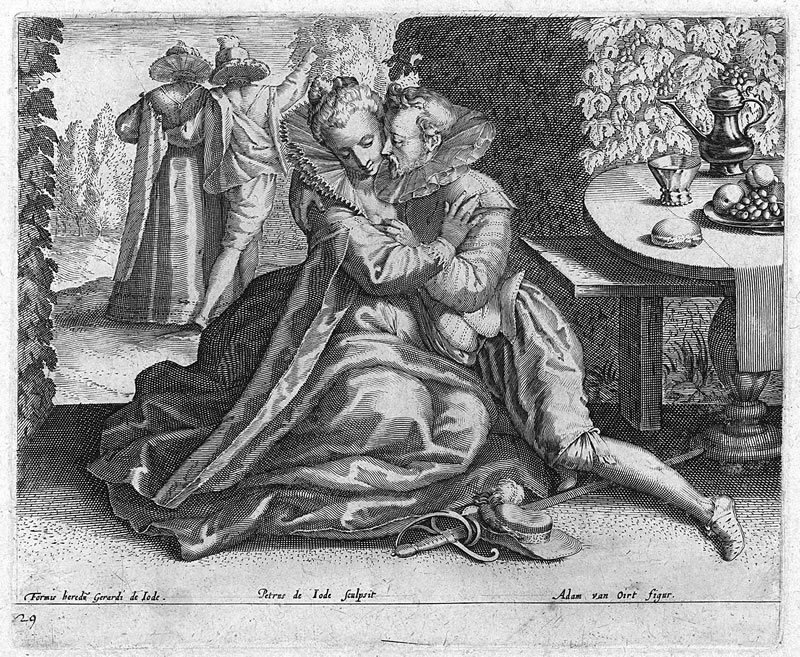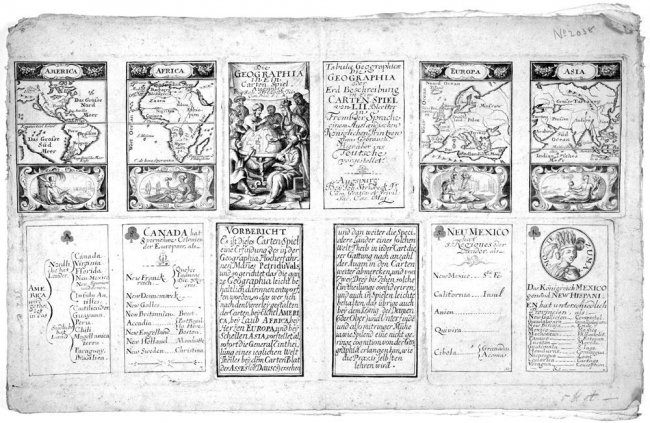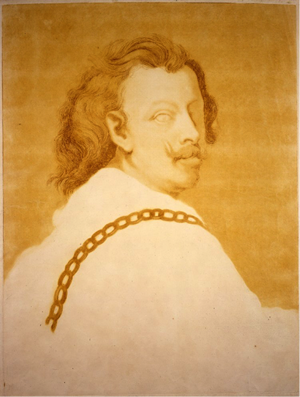The Antwerp De Jode family consists of four generations of publishers, designers and engravers, working between c.1550 and 1670, throughout the ‘golden age’ of Flemish printmaking

Gerard de Jode (1516/17-1591) and Cornelis de Jode (1571-1600) A substantial part of prints published by Gerard de Jode has been included in previous New Hollstein volumes on individual engravers and designers. However, recent focus in print research on publishers' funds, i.e. stocks of plates, has shown that important new insights can be made from the study of a publisher's entire fund. The present research of Gerard de Jode as a printmaker has tripled the number of prints attributed to him in Hollstein (vol. IX, pp. 200-202) to c.1250, a number that comes much closer than was previously known to the output of Hieronymus Cock's contemporary publishing firm Aux quatre Vents, estimated to have contained c.1600 plates.
The fact that Gerard de Jode therefore can be regarded as the second most succesful Antwerp print publisher of the mid-16th century justifies the revised and improved publication of all prints issued by him, including his entire print bible (the Thesaurus) and atlas (the Speculum Orbis Terrarum). A complete overview of De Jode's stock sheds new light on De Jode's working methods, his connections, and on how political, commercial and aesthetic changes influenced his output. The present volumes are based in part on unpublished research, conducted by Peter van der Coelen and Chris Schuckman during the 1990's, and graciously made available to the compiler.
The introduction to the volumes by Peter van der Coelen gives him the opportunity to publish his research on Gerard de Jode, and on the print bible in particular. This will complement Peter van der Coelen's many publications on religious prints and print bibles, as well as his recent biographies of the members of the de Jode family in Saur's Künstlerlexikon.
Gerard de Jode came to Antwerp from Nijmegen and enrolled in the Antwerp Guild of Saint Luke in the year 1547/48 as a print dealer. In 1549 he was mentioned as a dealer of books and paintings. He obtained a printing permit in December 1550. However, the first dated prints carrying De Jode's address did not appear until five years later, e.g. an Italian World Map of 1555 [fig. 1]. From this year onwards De Jode started to build up his stock of plates, more or less following the lead of Hieronymus Cock and working, in part, with the same designers and engravers.
Both published, during the 1550's and 1560's, wall maps and series of ornament prints. Although Gerard de Jode has been mentioned in documents as an engraver, the only instances in which De Jode actually signed prints are two maps. Some of De Jode's wall maps and several of the maps for his atlas, the Speculum Orbis Terrarum, were etched and engraved by the brothers Joannes and Lucas van Doetecum.
They also made most of the series of ornament and architectural prints De Jode published, which were mostly designed by Hans Vredeman de Vries. These are included in the New Hollstein volumes of The van Doetecum Family and Vredeman de Vries. However, a complete compilation of De Jode's wall maps and atlas was a desideratum, which is met in the present volumes.
Similarly, several series of ornament and architectural prints were undescribed so far. For the invention of religious and profane subject matter Cock and De Jode could rely on the painters of the so called romanesque school which was at its height during the middle decades of the 16th century. They both published prints after inventions by Frans Floris, Michiel Coxie, Crispijn van den Broeck, Maarten van Cleve and others. Cock had many of his religious series made by the Amsterdam engraver Harmen Muller after designs by Maarten van Heemskerck. De Jode published two series by these Dutch artists. However, De Jode worked mostly with less renowned engravers than Cock employed.
Several of De Jode's prints seem to have been engraved by Petrus Jalhea Furnius, who never signed his early prints for De Jode but whose rather crude technique is easily recognisable. Some of these large engravings are quite remarkable, such as the Agony in the Garden after Lambert Lombard, or the Christ in the House of Simon after a painting by Vasari [fig. 2], both only known in unique impressions and previously unpublished in the literature about either of these artists. In 1570 Cock died and his business was continued by his widow Volcxken Diericx. In the same year the Haarlem engraver and publisher Philips Galle settled his firm in Antwerp, which would soon come to dominate Antwerp printmaking.
De Jode had worked with Philips Galle even before the latter's move to Antwerp and in 1572 Galle and De Jode together published a series of Portraits of Popes. This series is mentioned in the New Hollstein volumes on Philips Galle but was not known to have been published in a second edition with Gerard de Jode, who re-published the augmented series in a third edition in 1585, without Galle [figs. 3-4]. In an even later edition, of 1618, the series was published again by Gerard's son Pieter de Jode I, a fact that was equally unknown.
During the 1570's and 1580's Galle and De Jode employed several of the same engravers, among them the Wierix brothers and the Collaerts, as well as designers such as Maarten de Vos. This part of De Jode's output was published in the Hollstein volumes on Maarten de Vos and The Wierix family, and in the New Hollstein, The Collaert Dynasty, which were critically revised for the present volumes. Not published before are most prints after Jan Snellinck, De Jode's son-in-law and from 1574 his main designer. Several of these prints were unknown, others could be attributed to Jan Snellinck in comparison with his signed work [fig. 5].
De Jode's most important business associate seems to have been the Antwerp book publisher Christoffel Plantin. This has been concluded from Plantin's account books in which de Jode is often mentioned as supplier of cartographic work and other prints, which were sold by Plantin. In 1579 and 1584 De Jode and Plantin published two books together, the emblem book Mikrokosmos Parvus Mundus, with texts by Laurens van Haecht and illustrations after Jan Snellinck, and Jan Moerman's, Apologi Creaturarum, animal fables with illustrations after Marcus Gheeraerts, which also contains a poem by De Jode's own hand. Both publications were highly succesful but little regarded in the later literature of the genre. They are now fully described and illustrated [fig. 6].
Gerard de Jode's largest project was his print bible, known as the Thesaurus. Published first in 1579 in an Old Testament edition only, the Thesaurus consisted mostly of a compilation of series which De Jode already had in stock. To the second edition, of 1585, he added newly engraved series to the Old Testament and also added the New Testament. Between these two editions something interesting happened, which sets De Jode apart from other publishers. In the second edition several plates were replaced by new ones or heavily reworked. It can only be concluded that De Jode felt the need to aesthetically update his older prints, something no other contemporary publisher is known to have done [figs. 7-8].
Since Hans Mielke's article of 1975 in Zeitschrift für Kunstgeschichte, no comprehensive study has been published on the Thesaurus. The present New Hollstein volumes will start with all prints in all editions, fully illustrated in all relevant states. The series already published in previous volumes were critically assessed, states were revised and some new states could be added.
All title cartouches to the separate series were traced and will be illustrated in the section on the Thesaurus as well as under the ornament print series, since Gerard de Jode also published them in both forms. It can be concluded that Gerard de Jode worked in many fields of printmaking, continuously updating his stock, well connected both nationally and internationally. A last print with his address was posthumously dated 1592; this very interesting and undescribed emblem on the disciplining of children, or, on a higher level, the unchangebility of human nature, gives proof of the great versatility of the Antwerp publisher [fig. 9].
The De Jode publishing firm was continued after 1591 by Gerard de Jode's widow, Passchijnke van Gelre, and his son Cornelis. The latter was an engraver but also a surveyer and cartographer. In this capacity he re-issued his father's atlas, with the changed title of Speculum Orbis Terrae, to which he added several new or updated maps. Cornelis de Jode also published a booklet on surveyer's instruments in 1594, in Nuremberg. The illustrations can be attributed to him; interestingly, the plates are kept to this day in Antwerp, in the Museum Plantin-Moretus. From documents it was known that both Gerard and Cornelis de Jode made prints meant for terrestial and heavenly globes. A unique series of gores for a large terrestial globe has been attributed to Gerard de Jode. Recently a terrestial globe by Cornelis de Jode has surfaced [fig. 10]. He travelled to Italy, Norway, Denmark and Iceland, and died in 1600 on his way home from a commercial trip to Spain. The existing Hollstein entry on Cornelis de Jode (vol. IX, p. 200) consists of just one print, which turned out to be erroneous. Besides the cartographic works mentioned above, five more plates were traced with the excudit of Cornelis de Jode, proving that he did continue the family firm's stock of plates.
Compiler: Marjolein Leesberg
Editors: Peter van der Coelen, Huigen Leeflang



